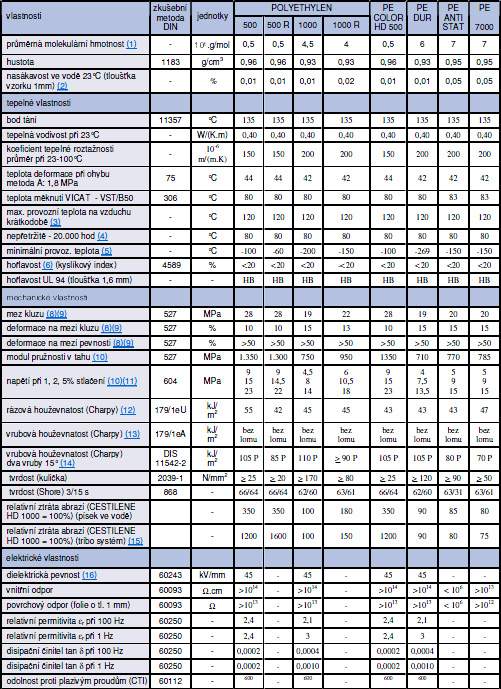Polyethylene

HD-PE - High density polyethylene
Due to its non-polar structure, HD-PE has unusually high resistance to chemicals and other media. It is resistant to acids, alkalis, salt solutions, alcohols and petrol. In principle, the chemical resistance of partially crystalline thermoplastics increases with increasing temperature. It is not resistant to strong oxidizing agents, such as nitric acid, ozone, sulphuric acid vapour, hydrogen peroxide and halogens.
It diffuses aromatic and halogenated hydrocarbons, certain types of oils, fats and waxes in small quantities,. The diffusion is very small up to 30 °C. PE combusts by flame impingement and no harmful substances incompatible with the environment are created when burnt. The SN 73 0862 standard puts PE in the C3 class - easily flammable.
Typical properties of Polyethylene PolyETHEN (HDPE)
- low density
- great stiffness
- high elongation value
- use at temperatures from - 50 to + 90 °C (max. at zero pressure)
- good electrical insulation properties
- very good chemical resistance
- low water and water steam absorption
- low price
- easy workability
Calculation Table

(1) The calculation is based on Margules equation M = 5.37 x 104 x [h] 1.49, where [h] is the Staudinger index derived from viscosity measurements using Decahydronaphthalene as a solvent (concentration of 0.0005 g/cm3 for PE-HMW and 0.0003 g/cm3 for PE-UHMW).
(2) Conducted on 1 mm thick plates.
(3) Only for short-term exposure (a few hours) in situations where the material is slightly burdened or not at all.
(4) After this time the tensile strength decreases to about 50% of the original value. The temperatures are based on thermal-oxidative degradation, which causes a variation in the properties. As with all other thermoplastics, the maximum allowable operating temperature depends in many cases mainly on the duration and magnitude of the mechanical pressure that the material is exposed to.
(5) The impact strength decreases as the temperature drops. The minimum allowable service temperature is determined by the extent to which the material is subjected to impacts. The values ??are based on unfavourable impact conditions and cannot be considered as an absolute practical limit.
(6) The values are usually derived from data provided by the raw material suppliers. They should not reflect hazards that create threats under actual fire conditions.
(8) Test sample: Type 1 B
(9) Test speed: 50 mm/min.
(10) Test speed: 1 mm/min.
(11) Test samples: cylinders – 12 x 30 mm.
(12) Pendulum used: 15 J.
(13) Pendulum used: 5 J.
(14) Pendulum used: 25 J.
(15) Test conditions: pressure 3 MPa, speed 0.33 m/s, roughness of the metal disc Ra = 0.25 – 0.40 mm, total elapsed distance 28 km, without lubricant in a normal environment (air, 23 °C/50 % rel. humidity)
(16) Electrodes: Ø 25/Ø 75, in a transformer oil according to IEC 60296, test samples 1 mm thick, natural. Please note that the electric strength of black extruded materials can only reach 50% of the value for natural materials.
(2) Conducted on 1 mm thick plates.
(3) Only for short-term exposure (a few hours) in situations where the material is slightly burdened or not at all.
(4) After this time the tensile strength decreases to about 50% of the original value. The temperatures are based on thermal-oxidative degradation, which causes a variation in the properties. As with all other thermoplastics, the maximum allowable operating temperature depends in many cases mainly on the duration and magnitude of the mechanical pressure that the material is exposed to.
(5) The impact strength decreases as the temperature drops. The minimum allowable service temperature is determined by the extent to which the material is subjected to impacts. The values ??are based on unfavourable impact conditions and cannot be considered as an absolute practical limit.
(6) The values are usually derived from data provided by the raw material suppliers. They should not reflect hazards that create threats under actual fire conditions.
(8) Test sample: Type 1 B
(9) Test speed: 50 mm/min.
(10) Test speed: 1 mm/min.
(11) Test samples: cylinders – 12 x 30 mm.
(12) Pendulum used: 15 J.
(13) Pendulum used: 5 J.
(14) Pendulum used: 25 J.
(15) Test conditions: pressure 3 MPa, speed 0.33 m/s, roughness of the metal disc Ra = 0.25 – 0.40 mm, total elapsed distance 28 km, without lubricant in a normal environment (air, 23 °C/50 % rel. humidity)
(16) Electrodes: Ø 25/Ø 75, in a transformer oil according to IEC 60296, test samples 1 mm thick, natural. Please note that the electric strength of black extruded materials can only reach 50% of the value for natural materials.
